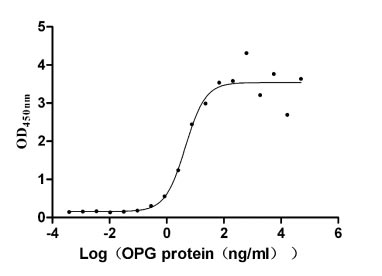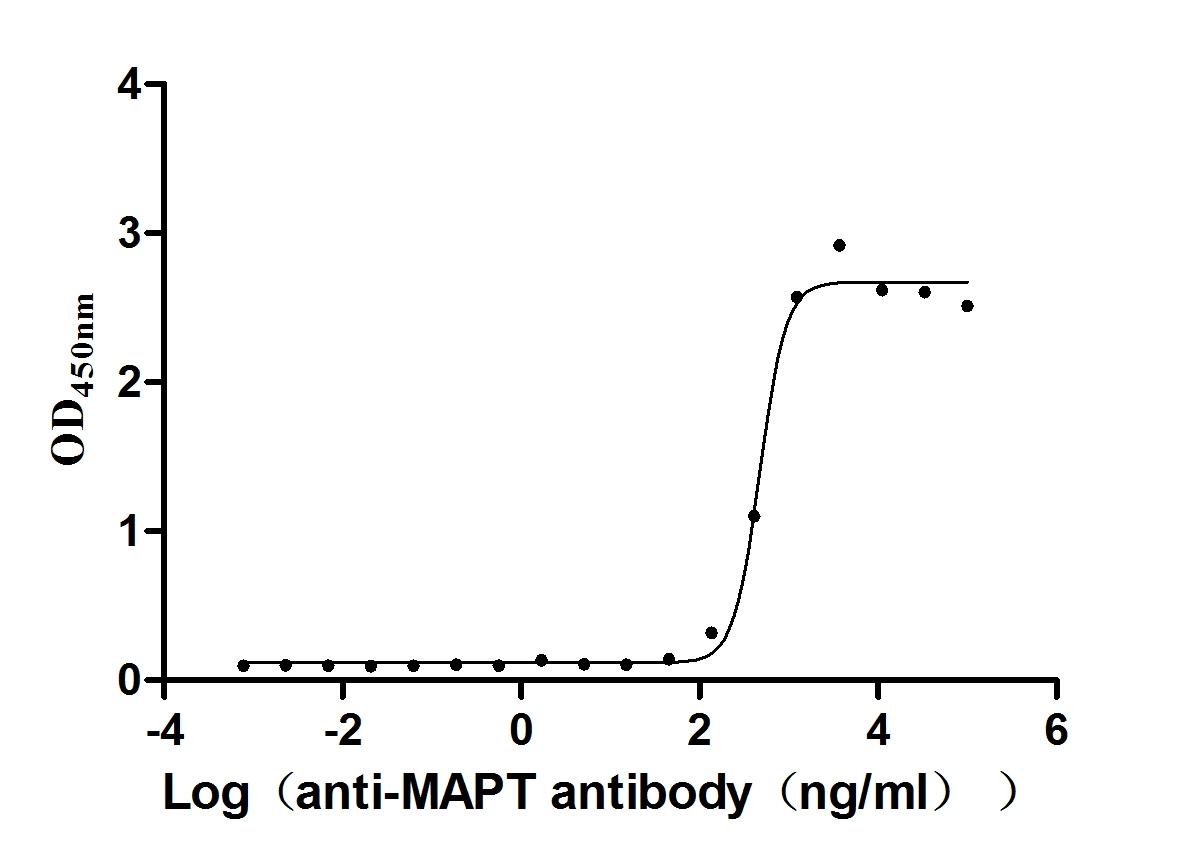Recombinant Rat Thioredoxin-interacting protein (Txnip)
-
货号:CSB-YP683628RA
-
规格:
-
来源:Yeast
-
其他:
-
货号:CSB-EP683628RA
-
规格:
-
来源:E.coli
-
其他:
-
货号:CSB-EP683628RA-B
-
规格:
-
来源:E.coli
-
共轭:Avi-tag Biotinylated
E. coli biotin ligase (BirA) is highly specific in covalently attaching biotin to the 15 amino acid AviTag peptide. This recombinant protein was biotinylated in vivo by AviTag-BirA technology, which method is BriA catalyzes amide linkage between the biotin and the specific lysine of the AviTag.
-
其他:
-
货号:CSB-BP683628RA
-
规格:
-
来源:Baculovirus
-
其他:
-
货号:CSB-MP683628RA
-
规格:
-
来源:Mammalian cell
-
其他:
产品详情
-
纯度:>85% (SDS-PAGE)
-
基因名:
-
Uniprot No.:
-
别名:Txnip; Vdup1; Thioredoxin-interacting protein; Vitamin D3 up-regulated protein 1
-
种属:Rattus norvegicus (Rat)
-
蛋白长度:full length protein
-
表达区域:1-394
-
氨基酸序列MVMFKKIKSF EVVFNDPEKV YGSGEKVAGR VTVEVCEVTR VKAVRILACG VAKVLWMQGS QQCKQTLDYL RYEDTLLLED QPTGENEMVI MRPGNKYEYK FGFELPQGPL GTSFKGKYGC VDYWVKAFLD RPSQPTQEAK KNFEVMDLVD VNTPDLMAPV SAKKEKKVSC MFIPDGRVSV SARIDRKGFC EGDDISIHAD FENTCSRIVV PKAAIVARHT YLANGQTKVL TQKLSSVRGN HIISGTCASW RGKSLRVQKI RPSILGCNIL RVEYSLLIYV SVPGSKKVIL DLPLVIGSRS GLSSRTSSMA SRTSSEMSWI DLNIPDTPEA PPCYMDVIPE DHRLESPTTP LLDDVDDSQD SPIFMYAPEF QFMPPPTYTE VDPCVLNNNN NNVQ
-
蛋白标签:Tag type will be determined during the manufacturing process.
The tag type will be determined during production process. If you have specified tag type, please tell us and we will develop the specified tag preferentially. -
产品提供形式:Lyophilized powder
Note: We will preferentially ship the format that we have in stock, however, if you have any special requirement for the format, please remark your requirement when placing the order, we will prepare according to your demand. -
复溶:We recommend that this vial be briefly centrifuged prior to opening to bring the contents to the bottom. Please reconstitute protein in deionized sterile water to a concentration of 0.1-1.0 mg/mL.We recommend to add 5-50% of glycerol (final concentration) and aliquot for long-term storage at -20℃/-80℃. Our default final concentration of glycerol is 50%. Customers could use it as reference.
-
储存条件:Store at -20°C/-80°C upon receipt, aliquoting is necessary for mutiple use. Avoid repeated freeze-thaw cycles.
-
保质期:The shelf life is related to many factors, storage state, buffer ingredients, storage temperature and the stability of the protein itself.
Generally, the shelf life of liquid form is 6 months at -20°C/-80°C. The shelf life of lyophilized form is 12 months at -20°C/-80°C. -
货期:Delivery time may differ from different purchasing way or location, please kindly consult your local distributors for specific delivery time.Note: All of our proteins are default shipped with normal blue ice packs, if you request to ship with dry ice, please communicate with us in advance and extra fees will be charged.
-
注意事项:Repeated freezing and thawing is not recommended. Store working aliquots at 4°C for up to one week.
-
Datasheet :Please contact us to get it.
相关产品
靶点详情
-
功能:May act as an oxidative stress mediator by inhibiting thioredoxin activity or by limiting its bioavailability. Interacts with COPS5 and restores COPS5-induced suppression of CDKN1B stability, blocking the COPS5-mediated translocation of CDKN1B from the nucleus to the cytoplasm. Inhibits the proteasomal degradation of DDIT4, and thereby contributes to the inhibition of the mammalian target of rapamycin complex 1 (mTORC1). Functions as a transcriptional repressor, possibly by acting as a bridge molecule between transcription factors and corepressor complexes, and over-expression will induce G0/G1 cell cycle arrest. Required for the maturation of natural killer cells. Acts as a suppressor of tumor cell growth.
-
基因功能参考文献:
- This study found that acupuncture treatment alleviated cognitive decline and hippocampal neuronal death by inhibiting cerebral oxidative stress and inflammation, which was probably through downregulating TXNIP expression. PMID: 29110407
- TXNIP contributes to the dysregulation of tubular autophagy and mitophagy in diabetic nephropathy through activation of the mTOR signaling pathway. PMID: 27381856
- results demonstrated, for the first time, that SalA protects against HFD-induced NAFLD by ameliorating hepatic lipid accumulation and inflammation, and these protective effects may partially due to regulation of the TXNIP/NLRP3 and TXNIP/ChREBP pathways. PMID: 27345365
- The results of this study may represent the critical evidence to support the pro-inflammatory and pro-apoptotic effects of TXNIP after SAH. PMID: 28490373
- TXNIP level is also significantly upregulated in the diabetic rat retina in vivo and induces radial glial fibrillary acidic protein expression, a marker for Muller glia activation, and the formation of LC3BII puncta, which are prevented by intravitreal injection of TXNIP siRNA. PMID: 28492550
- histone acetylation serves as a key regulator of glucose-induced increase in TXNIP gene expression PMID: 27989964
- TXNIP may participate in EBI after SAH by mediating apoptosis. The blockage of TXNIP induced by PERK could be a potential therapeutic strategy for SAH treatment. PMID: 28420192
- Down-regulation of TXNIP or inhibition of NLRP3 contributed to the suppression of NLRP3 inflammasome activation, inflammation, and re-balanced lipid metabolism. In contrast, overexpression of TXNIP or agonism of NLRP3 exacerbated the cellular damage induced by sodium palmitate. PMID: 26133299
- high glucose and lipopolysaccharide activate ROS/TXNIP/ NLRP3/IL-1beta inflammasome signaling in glomerular mesangial cells PMID: 26881256
- ITCH targets TXNIP for ubiquitin-proteasome degradation in cardiomyocytes and ameliorates reactive oxygen species-induced cardiotoxicity through the thioredoxin system. PMID: 26796253
- These findings thereby provide new mechanistic insight into the regulation of TXNIP and beta-cell biology and reveal novel links between proinflammatory cytokines, carbohydrate response element binding protein-mediated transcription, and microRNA signaling. PMID: 26858253
- characterized TXNIP as a presently unrecognized molecule implicated in the regulatory actions of Cx43 on oxidative drug injury. PMID: 26154105
- Androgen receptor silences thioredoxin-interacting protein and competitively inhibits glucocorticoid receptor-mediated apoptosis in pancreatic beta-Cells.( PMID: 25639671
- A novel mechanism is provided for fructose-induced nonalcoholic fatty liver disease pathogenesis by which the ROS-TXNIP pathway mediates hepatocellular NLRP3 inflammasome activation, inflammation and lipid accumulation. PMID: 25602171
- Evidence for enhanced TXNIP expression in hypertension and HFD-induced retinal oxidative/inflammatory response and suggest that TXNIP is required for HFD-mediated activation of the NLRP3 inflammasome and the release of IL-1beta in endothelial cells PMID: 24201577
- Data suggest hepatic expression of Txnip can be regulated by dietary factors; here, quercetin, an antioxidant dietary supplement, down-regulates expression of Txnip in liver of rats with type 1 diabetes to prevent non-alcoholic fatty liver disease. PMID: 23647015
- Hyperglycemia enhances myocardial Txnip expression, possibly through reciprocally modulating p38 MAPK and Akt activation, leading to aggravated oxidative stress and amplification of cardiac injury following myocardial ischemia-reperfusion injury. PMID: 23305039
- TXNIP up-regulation under chronic hyperglycemia is critically involved in cellular oxidative stress, DNA damage and retinal pericyte apoptosis. PMID: 23353834
- hyperglycemia sustains TXNIP up-regulation in Muller glia and evokes a program of cellular defense/survival mechanisms that ultimately lead to oxidative stress, ER stress/inflammation, autophagy and apoptosis. PMID: 22474421
- Enhanced TXNIP expression disrupted Trx/ASK-1 inhibitory complex leading to release of ASK-1 and activation of the pro-apoptotic p38 MAPK/JNK pathway, as indicated by cleaved PARP and caspase-3 expression. PMID: 21434880
- TXNIP has a critical role in inflammation and retinal injury in early stages of diabetic retinopathy. PMID: 21364670
- These results suggest that high glucose exposure improves Txnip mRNA and protein expression level by reactive oxygen species/MEK/MAPK signaling pathway. PMID: 20953987
- Data show that TXNIP shuttles between subcellular compartments in response to oxidative stress and identified a novel redox-sensitive mitochondrial TXNIP-Trx2-ASK1 signaling cascade. PMID: 19959470
- Fatty acids do not induce beta-cell expression of proapoptotic TXNIP, but TXNIP deficiency specifically inhibits the mitochondrial death pathway underlying beta-cell glucotoxicity. PMID: 19875615
- Study shows evolutionarily conserved expression patterns of VDUP1 in Drosophila and rat nervous systems, including subcellular localization--cytoplasmic enrichment in neurons and nuclear expression in glia. PMID: 19824090
- The thioredoxin inhibitor Txnip is a critical regulator of biomechanical signaling. PMID: 15123525
- results indicate a role for Txnip in the metabolic response to feeding and the maintenance of the redox status PMID: 15520447
- results suggest that loss of thioredoxin-binding protein-2 is essential for proliferation of neoplastic and non-neoplastic renal tubular cells & that it is a target gene in oxidative stress-induced renal carcinogenesis by ferric nitrilotriacetate [TBP-2] PMID: 15834431
- direct role for VDUP1 in the adverse effects of ischemia and oxidative stress on cardiomyocyte survival, left ventricular collagen deposition, and cardiac function PMID: 16172122
- individual genes and groups of genes were found to be dysregulated in diabetic neuropathy; the most significant of these was thioredoxin interacting protein (Txnip PMID: 16938273
- soleus muscle subjected to hindlimb unloading resulted in an increase in mRNA expression of TBP-2, a negative regulator of thioredoxin, followed by muscle atrophy PMID: 16983998
- Results suggest that high glucose induces Txnip through a TGF-beta1-independent pathway. PMID: 17675577
- The high olive oil diet does not change the tumour expression of H19 and VDUP1. PMID: 19337063
- TXNIP over-expression in endothelial cells abolishes H3K9 tri-methylation, a marker for gene inactivation, and increases H3K9 acetylation, an indicator of gene induction, at proximal Cox2 promoter bearing the NF-kappaB-binding site. PMID: 19562690
显示更多
收起更多
-
亚细胞定位:Cytoplasm.
-
蛋白家族:Arrestin family
-
数据库链接:
KEGG: rno:117514
STRING: 10116.ENSRNOP00000028793
UniGene: Rn.2758
Most popular with customers
-
Recombinant Human Tumor necrosis factor receptor superfamily member 11B (TNFRSF11B) (Active)
Express system: Mammalian cell
Species: Homo sapiens (Human)
-
Recombinant Human E3 ubiquitin-protein ligase ZNRF3 (ZNRF3), partial (Active)
Express system: Mammalian cell
Species: Homo sapiens (Human)
-
Recombinant Mouse Microtubule-associated protein tau (Mapt) (Active)
Express system: Mammalian cell
Species: Mus musculus (Mouse)
-
Recombinant Human Claudin-4 (CLDN4)-VLPs (Active)
Express system: Mammalian cell
Species: Homo sapiens (Human)
-
Recombinant Human Dickkopf-related protein 1 (DKK1) (Active)
Express system: Mammalian cell
Species: Homo sapiens (Human)
-
Recombinant Human C-C chemokine receptor type 8 (CCR8)-VLPs (Active)
Express system: Mammalian cell
Species: Homo sapiens (Human)
-
Recombinant Human Interleukin-2 receptor subunit alpha (IL2RA), partial (Active)
Express system: Mammalian cell
Species: Homo sapiens (Human)
-
Recombinant Mouse Gastric inhibitory polypeptide receptor (Gipr), partial (Active)
Express system: Mammalian cell
Species: Mus musculus (Mouse)






-AC1.jpg)













